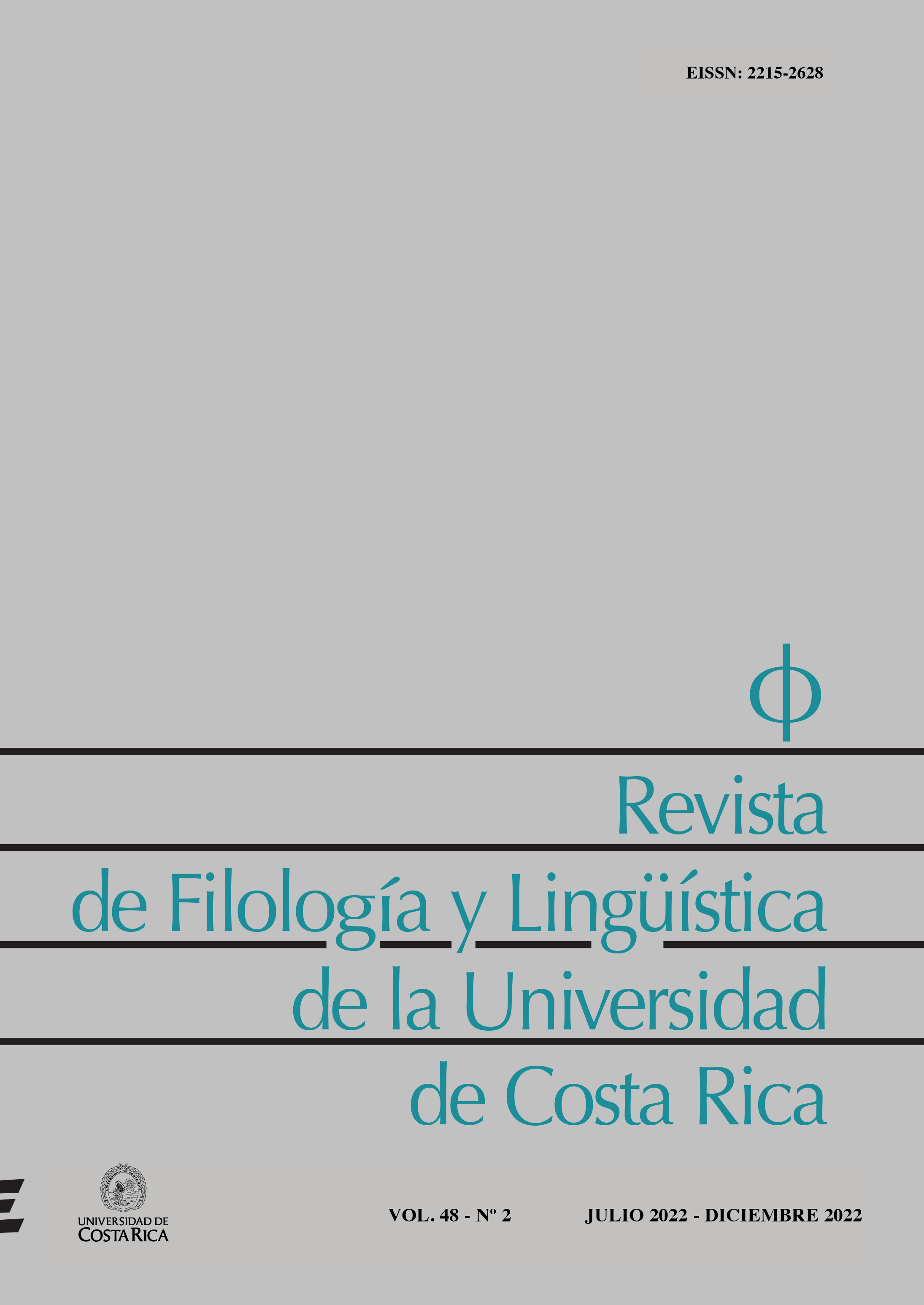Abstract
In the present research we analyze some of the main mechanisms involved in the construction of micro-dialogical humor (memes): homophony, homography, paronymy, synonymy, antonymy, holonymy and meronymy, hyperonymy and hyponymy, polysemy, semantic fields, decontextualization, contextual shock, invention of terms through morphological inflection or wordplay made from phraseological units. From an ad hoc corpus –extracted from humorous collective profiles from Facebook, Twitter, and Instagram– we present a lexical-semantic and pragmatic study on the generation and interpretation of micro-dialogical humor, whose objective is the identification and distinction of the mechanisms used for its construction and the explicitness of the implicit contents involved in its comprehension. The study uses as differential indicators the “extensionality”, the “paradigm”, and the “mental space” of the trigger words and analyzes the functioning of the associative flows that take place in the ostensive-inferential processes responsible for the humor in micro-dialogues. As a conclusion, we detect 1) structural patterns linked to unpredictability and surprise in relation to the exposure of stupidity and incomprehension and 2) micro-dialogues in which creativity and lateral thinking create humor through inferable contents.
References
Abril, G. (s. f.). Comicidad. En Diccionario Crítico de Ciencias Sociales. [pdf]. Recuperado de https://webs.ucm.es/info/eurotheo/diccionario/C/comicidad_humor.pdf
Alcaraz Varó, E. y Martínez Linares, M. A. (1997). Diccionario de lingüística moderna. Barcelona: Editorial Ariel.
Anscombre, J. C. y Ducrot, O. (1983). L´argumentation das langue. Bruselas: Mardaga.
Auer, P. (2005). Projection in interaction and projection in grammar. Text-Interdisciplinary journal for the study of discourse, 25(1), 7-36.
Bergson, H. (1939). La risa. Ensayo sobre el significado de lo cómico. Buenos Aires: Losada.
Clark, H. (1996). Using Language. Cambridge: Cambridge University Press.
Coseriu, E. (1967). Determinación y entorno. En Teoría del lenguaje y lingüística en general (pp. 282-323). Madrid: Gredos.
De Saussure, F. (1945). Curso de lingüística general. Buenos Aires: Losada.
Fauconnier, G. y Turner, M. (1995). Blending as a Central Process of Grammar. En A. Goldberg (Ed.), Conceptual Structure, Discourse, and Language (pp. 113-130). Stanford: Center for the Study of Language and Information.
Frege, G. (1996). Los fundamentos de la aritmética. Escritos filosóficos. Barcelona: Crítica.
Freud, S. (1988). El chiste y su relación con lo inconsciente. Obras Completas. (Vol. 5). Buenos Aires: Hyspamérica.
Gadamer, H. G. (1986-1995). Gesammelte Werke. Tübingen: Mohr.
Gumperz, J. J. (1982a). Discourse strategies. Cambridge: Cambridge University Press.
Gumperz, J. J. (1982b). Language and social identity. Cambridge: Cambridge University Press.
Heritage, J. (1984). Garfinkel and Ethnomethodology (Social & Political Theory). Cambridge: Polity Press.
Jakobson, R. (1985). Lingüística y poética. Madrid: Cátedra.
Lamiquiz, V. (1989). Lengua española. Método y estructuras lingüísticas. Barcelona: Ariel Lingüística.
Lyons, J. (1989). Semántica. Barcelona: Teide.
Minsky, M. (1975). A Framework for Representing Knowledge. En P. H. Winston (Ed.), The Psychology of Computer Vision (pp. 211-277). New York: McGraw-Hill.
Ochs, E. (1979). Introduction: What Child Language Can Contribute to Pragmatics. En E. Ochs y B. Schieffelin (Eds.), Developmental Pragmatics (pp. 1-17). New York: Academic Press.
Pelletier, F. J. (2001). Did Frege Believe Frege’s Principle? Journal of Logic, Language, and Information, 10, 87-114.
Penco, C. (1999). Objective and Cognitive Context. En P. Bouquet, L. Serafini, P. Brézillon, M. Benerecetti y F. Castellani (Eds.), Modeling and Using Context (Proceedings of CONTEXT’99) (pp. 270-283). Berlín: Springer.
Portillo-Fernández, J. (2013). Lo absurdo: descontextualización, sentido, significado y humor. Revista de Humanidades de Valparaíso (RHV), 2, 105-134.
Portillo-Fernández, J. (2017). Análisis del choque contextual en la argumentación absurda humorística. Philologia hispalensis, 31(1), 91-118.
Portillo-Fernández, J. (2018). Enfoques y límites del humorismo sobre discapacidad. Su verdadera cromática. Revista Española de Discapacidad, 6(2), 173-187.
Portillo-Fernández, J. y Salguero-Lamillar, F. J. (2017). Mecanismos cognitivos para el enriquecimiento semántico del discurso mediante funciones de mapeo. Moenia - Revista lucense de lingüística y literatura, 23, 529-558.
Real Academia Española. (2014). Diccionario de la lengua española. (23 ed.). [Versión 23.4 en línea]. Recuperado de https://dle.rae.es/
Rosch, E. (1978). Principles of Categorization. En E. Rosch y B. L. Lloyd (Eds.), Cognition and Categorization (pp. 27-48). Lawrence Erlbaum: Hillsdale, NJ.
Salguero Lamillar, F. J. (2010). A validade do(s) Princípio(s) de Frege na análise da linguagem natural. Kairos: Journal of Philosophy & Science, 1, 43-54.
Schank, R. y Abelson, R. (1987). Guiones, planes, metas y entendimiento. Barcelona: Paidós.
Searle, J. (1998). Mente, lenguaje y realidad. La filosofía en el mundo real. Madrid: Alianza.
Sperber, D. y Wilson, D. (1986). Relevance: Communication and Cognition. Oxford: Basil Blackwell.
Steimberg, O. (2001). Sobre algunos temas y problemas del análisis del humor gráfico. Signo y Seña, 12, 99-118.
Trier, J. (1931). Der deutsche Wortschatz im Sinnbezirk des Verstandes. Die Geschichte eines sprachlichen Feldes. Heidelberg: C. Winter.
Wright, S. E. y Budin, G. (Eds). (1997). Handbook of Terminology Management. (Vol. 1). Amsterdam: John Benjamins.

